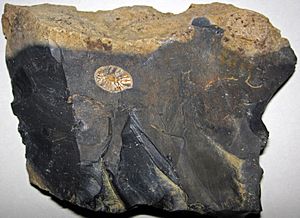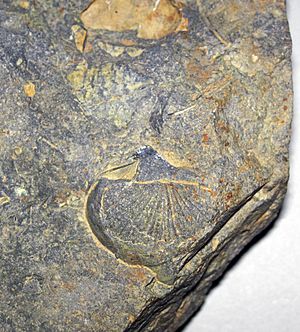Upper Mercer flint facts for kids
Upper Mercer flint or Upper Mercer chert is a special type of rock found in Coshocton, Hocking, and Perry counties in Ohio. It is a very hard and pure form of flint or chert. This stone is made of a material called silica, which is also found in quartz.
Long ago, people used this strong, brittle stone to make tools and weapons. They would heat the flint to make it easier to chip. Then, they carefully chipped it to create very sharp edges. This process helped them make useful items like spearheads, scrapers, knives, and arrows.
Contents
What is Upper Mercer Flint?
Upper Mercer flint is a type of flint or chert. It's a very hard rock made mostly of silica. Think of it as a super tough, natural glass. Because it's so hard and can be chipped into sharp pieces, it was perfect for making tools.
Where Does it Come From?
This flint is found deep underground in Ohio. It lies between layers of other rocks, like Cambridge Limestone and Brassfield Limestone. This rock formed a very long time ago, during the Paleozoic Era. Back then, seas covered what is now Ohio, and the flint was deposited there.
You can also find pieces of Upper Mercer flint on the surface. Giant glaciers that moved across Ohio in the past picked up and dropped these rocks. So, you might find them in areas where glaciers left behind soil and rocks.
One important place where this flint was found is the Welling Site. This was a quarry where ancient people dug for flint. It's located near the town of Nellie in the Walhonding River Valley. The hills around this valley are full of Upper Mercer flint.
How Ancient People Used Flint
People have known about the use of Upper Mercer flint by ancient people since 1945. For prehistoric people and Native Americans, having good quality tools was very important for their survival. They would travel hundreds of miles to find and dig for flint. They needed it to make new tools or replace broken ones.
Tools and Travel
Tools made from Upper Mercer flint have been found far from Ohio. During the Paleo-Indian period, which was a very long time ago, tools made from this flint were found in places like Michigan and West Virginia. This shows how far people traveled or how widely these tools were traded.
Later, during the Archaic period, tools made from Upper Mercer flint were found in many states. These include eastern Indiana, southern Michigan, southern Ontario (Canada), western Pennsylvania, and Ohio. It was used most often in north-central Ohio.
Flint's Journey Through Time
When early European settlers arrived, they also found uses for Upper Mercer flint. They used it to grind grain. It was also important for flintlock guns, which used a piece of flint to create a spark. People also used it as a fire starter.
Today, Upper Mercer flint is special because it's Ohio's official gemstone! People now use it to make beautiful jewelry.
Other places in Ohio where ancient people gathered flint include Flint Ridge. This is a large area with another type of flint called Vanport flint. Another site is Zaleski flint, found in Vinton and Jackson Counties.



